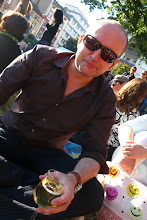I finally managed to get started with the Prussian ordnance fielded during the Seven Years' War. It is a most interesting subject to me, for there is so little image material found with the commercially available books on the Prussian army. Even with rare ones, long out of print.
I'm so fond with the first results, that I thought of sharing it in advance.
The below first illustration, therefore, is a sort of sneak preview, as I worked off-scale my regular sheet format. More details are to follow with my next completed sheet.
More information on Prussian artillery will soon be available in English language published in the Smoothbore Ordnance Journal by Digby Smith and Stephen Summerfield. Digby Smith has also done a wonderful translation of a rare paper by Hans Bleckwenn focusing on Prussian 7YW artillery.
At this point I wish to thank all who have supplied me with this wealth of material. I have received great support from many countries ranging from the US, UK, Denmark, Italy, France, and Germany. I have also received the official permission of the Stockholm Army Museum to use their image material.
My initial decision, to do this project in English language rather then in German turned out to be a good one. The audience grows so much larger.
My special thanks to David Morfitt ("Not by Appointment" Blog at nba-sywtemplates.blogspot.de ), who has contributed the nice illustrations of the Prussian barrels and carriages insignia.
Regarding the 'source situation’ on Prussian artillery which enables me to reconstruct the 7YW period pieces, I will draw most heavily on the single most valuable 4 volume work by Malinowsky & Bonin, Geschichte der brandenburg–preussischen Artillerie, vol. II, Berlin 1841. It provides most detailed descriptions on the evolution on barrel and carriage design, but comes without images. Regarding images, most authors work with the same four of five illustrations again and again, which implies not much has survived WWII. The former Berlin Zeughaus Museum owed a large collection of scale models of which but few pieces survived. Also the Potsdam Heeresarchiv had loads of scale drafts of about all pieces ever fielded or designed in Prussia. All was lost with a devasting air raid April 1945, it seems. Some scale drawings did survive in Germany or other collections, such as Denmark. Most are post 7YW, but are of good help nevertheless.
To make matters worse, some glaring errors are found with correctly identifying some of the images. None of the more recent Historians such as Dr. Hans Bleckwenn, Die fridrizianischen Uniformen, Osnabrück 1987; or Martin Guddat, Kanoniere Bombardiere, Pontoniere, Herford 1992 seem to have noticed. The flaws start with the 1911 published little booklet by Gohlke, Geschichte der gesamten Feuerwaffen bis 1850. Gohlke comes with 3 sample images of Prussian guns. Two of the three have false captions. Bleckwenn, at least, was more cautious with presenting his 12-pounder illustration "claimed" to be mounted on a M1762 carriage. Martin Guddat less so. He presents several images of a 12-pounder scale model, a black and white photo of another 12-pounder unlimbered and a 24-pounder limbered, and fails to notice that it is all different photographs of the same piece. It's a scale model of the "Austrian-type" 12-pounder designed by Dieskau in 1759, 18 shots long, and mounted on a M1774 carriage. Bleckwenn illustrated the piece in his book. The barrel design is equally the model for the casts of 1774 or later. The carriage is of similar design as with the heavy 12-pounder nicknamed "Growler" (German: Brummer) on display at the Paris Musée de l'Armée to the present day. A barrel 22 shots long and first cast in 1761. The famous "Growlers" first fielded at Leuthen in 1757 were heavy fortress or siege guns with 24 or 26 shots barrels, not the model on display in Paris. It's dimensions was rather close to the French Vallière 12-pounder found in my January 2012 post.
16 June 2012
Subscribe to:
Post Comments (Atom)








Christian as you know I am a huge fan of your work. I really think what you are doing is adding a lot to our knowledge of artillery of the time, in fact in the case of the Prussians I think your work is pioneering since there is little available that is easily accessible. Your working through the sources is a service to all those with serious interest in the SYW
ReplyDeleteYes, truly remarkable work and illustrations! Thank you.
ReplyDeleteBest Regards,
Stokes Schwartz
I'd like to second Clibinarium. I found your blog when researching how to create my cannon for my wooden soldiers and it was invaluable as well as inspirational. I'd love to send you one as a thank you.
ReplyDeleteIf you are interested please to PM me at my blog
www.skullandcrown.blogspot.com
Cheers
Thomas Foss
I must say Christian, you are dong a very fine job!
ReplyDeleteNow all that is needed is someone to make all of the different cannons, tools etc some us 18th century buttons counters can feel better about our armies LOL
cheers'
Matt
Another great addition to the list, always informative and a joy to read.
ReplyDeleteWe would love to have you join us on the site and have you as a contributor.
Thaank you for sharing
ReplyDelete